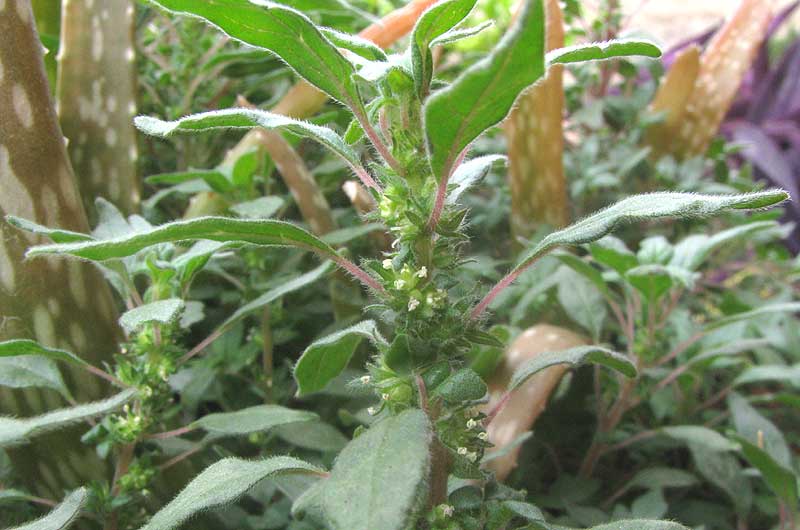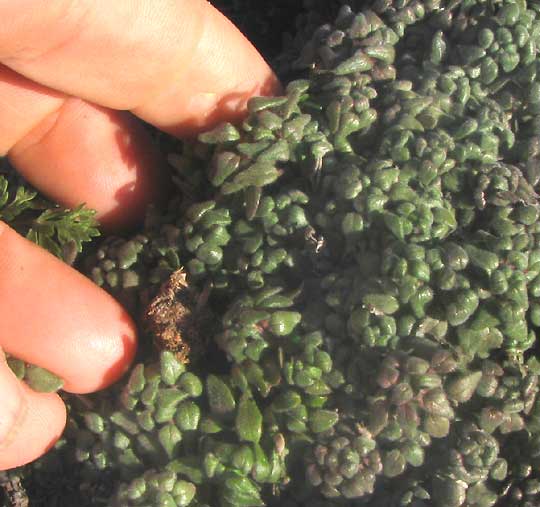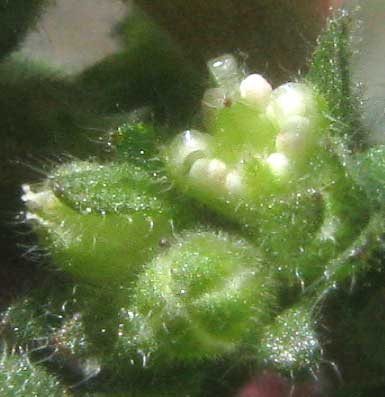Excerpts from Jim Conrad's
Naturalist Newsletter

from the the April 14, 2013 Newsletter issued from the Frio Canyon Nature Education Center in northern Uvalde County, southwestern Texas, on the southern border of the Edwards Plateau; elevation ~1750m (~5750 ft); N29.62°, W99.86°; USA
PENNSYLVANIA PELLITORY
In mid February when the garden was fallow a certain non-flowering herb caught my attention because it formed very dense, dark green, soft-hairy, carpetlike patches here and there on abandoned beds and hills. You can see my fingers at that time nudging into its downy-feeling herbage below:

As days began warming, the same herb appeared in many of my potted plants, needing to be pulled out. Above you can see a healthy specimen flowering in a pot of Aloe vera. A close-up of its tiny flowers is shown below:

In that picture the flower at the top, right shows an ovary surrounded by white, baglike anthers full of immature pollen. The shiny, curved, ribbonlike items at the flower's edge are incurved filaments, the stamens' "stems." This is a bisexual flower -- a flower with both male and female parts -- which becomes noteworthy when you know what plant this is, and what family it belongs to.
At first I thought the plant was Artillery Weed, Pilea microphylla, which has a knack for invading greenhouses and -- like our current fuzzy plant -- rooting in potted plants and seedbeds where it shouldn't be. Back in my student days we called Pilea microphylla Greenhouse Weed, and everyone knew what we were talking about. However, Pilea leaves are hairless, or "glabrous," while our present plant is abundantly hairy.
Our hairy plant is the Pennsylvania Pellitory, PARIETARIA PENSYLVANICA, a member of the Nettle Family, the Urticaceae, which is also the family my Greenhouse Weed belonged to, which explains the similarities. Most species in the Nettle Family bear unisexual flowers, so that's why our picture of a bisexual blossom is noteworthy. In fact, in the Pellitory genus Parietaria, flowers can be bisexual, all male or all female. In Parietaria flower clusters, blossoms nearest the stem are usually bisexual and male, while those farthest from the stem are typically female.
I had expected such a weedy and aggressive plant to be Eurasian but it turns out to be native American, found throughout most of the continent but most commonly in the central US states, and into Mexico. The online Flora of North America describes its habitat as "Dry ledges, talus slopes, waste and shaded places, primarily in neutral to basic soils, and reported from margins of hot springs in northernmost locations." Maybe its adaptations for "margins of hot springs" equip it for pots overwintering in people's homes.
Once I knew what it was, I harvested a handful of leaves and ate them raw, for another name of Pennsylvania Pellitory is Cucumber Weed. And it's true that the leaves have a decidedly cucumbery taste. The leaves are perfectly edible, but a bit fuzzy, and when young and most desirable for eating they're too small to make it worthwhile harvesting for cooked greens. Therefore, unless the revolution had come and you're starving, Pellitory is more for being eaten for the novelty of its unexpected cucumber taste than as a wild delicacy.
In the online Flora Medicinal Indígena de México, Pennsylvania Pellitory is called Hierba del Rayo, or "Lightning Herb." When lightning strikes nearby, frightens you so that you get chills, fevers, headache and maybe nosebleeds, this is the herb you grind into a pulp and form into a poultice that's applied to your head and kept there overnight by a rag tied around the head. The dried poultice is removed the next day, and the lightning's malignant influence is banished.